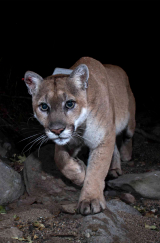
This program features personal stories by various individuals who made a connection with P-22 and understand the immediate need for wildlife protection, along with guests who answered an open mic call to share their knowledge and admiration for P-22. The evening features California Regional Executive Director for the National Wildlife Federation’s Beth Pratt, writer Martha Groves, author Sherry Mangel-Ferber, LA Times reporter Laura Nelson, Senior Manager of Community Science for Natural History Museum Miguel Ordeñana, Chumash and Tataviam elder Alan Salazar, and illustrator Alexander Vidal. The open mic welcomes (in order of appearance) playwright, actor, and musician Amy Raasch, LAPL librarian Tommy Bui, longtime ALOUD attendee Terrence Butcher, and Seed Program Manager of Theodore Payne Foundation Genevieve Arnold to share their remembrances.
A lifelong advocate for wildlife, Beth Pratt has worked in environmental leadership roles for over twenty-five years and in two of the country’s largest national parks: Yosemite and Yellowstone. As the California Regional Executive Director for the National Wildlife Federation, Pratt leads the #SaveLACougars campaign to build the Wallis Annenberg Wildlife Crossing, which broke ground on Earth Day, April 22, 2022. Her innovative conservation work has been featured by the Los Angeles Times, NPR, The New Yorker, and more. Author of I Heart Wildlife and When Mountain Lions are Neighbors, her new book Yosemite Wildlife will be published in 2024. She has also contributed to the books The Nature of Yosemite and Inspiring Generations as well as given a TEDx talk, How a Lonely Cougar in Los Angeles Inspired the World and is featured in the documentary, The Cat that Changed America. Pratt spends much of her time in Los Angeles but makes her home outside of Yosemite with her five dogs, two cats, and the wildlife that frequent her backyard.
Martha Groves, a lifelong journalist, had the good fortune to be the first reporter to write about P-22. After earning her master’s degree at Northwestern University’s Medill School of Journalism, she worked as an editor and arts and culture reporter at the Chicago Daily News. She moved to the Philadelphia Inquirer and then the Los Angeles Times, where she covered retailing, the economy of the West, tech, farming, management, education, and the Westside region. Since her retirement from the Times in 2015, she has been a freelance reporter and editor. She is a native Hoosier. In 1994, she adopted her daughter, Nora, in China. She is an avid traveler, hiker, and concertgoer and serves on the board of the Los Angeles Master Chorale.
Author Sherry Mangel-Ferber is a retired teacher who lives in Liberty Canyon in the Santa Monica Mountains. She is a volunteer for SaveLACougars and enjoys returning to the classroom to teach about the local wildlife. She spends as much time as possible outdoors, hiking, taking photographs of the scenic wonders of the area and, when possible, of the wildlife as well. When she is not outdoors, she can be found sewing, doing needlepoint, reading, baking, spending time with friends, or with her two rescue cats, Kit and Kaboodle.
Laura J. Nelson is an investigative and enterprise reporter at the Los Angeles Times. Her work has exposed and explained chaos in the U.S. Postal System, inequities in COVID-19 vaccine distribution, and the spread of far-right extremism in California’s world of health, wellness, and spirituality. She previously covered transportation, mobility, and commuting for The Times. Nelson was part of the team that won the 2016 Pulitzer Prize for its coverage of the San Bernardino terrorist attack, as well as the team that was a 2020 Pulitzer finalist for its coverage of a dive-boat fire that killed 34 people off the coast of Santa Barbara. Nelson grew up in Kansas and joined The Times in 2012.
Miguel Ordeñana is an environmental educator and wildlife biologist. He works at the Natural History Museum of Los Angeles County as a Senior Manager in the Community Science office. As a community science senior manager, Miguel promotes and creates community science projects and recruits and trains participants. Miguel utilizes his mammal research background by conducting urban mammal research in L.A. and leads NHMLAC’s Southern California Squirrel Survey and Backyard Bat Survey. Miguel serves as an advisor on a jaguar project in southwestern Nicaragua that he initiated in 2012 as well as a Board Member for the Friends of Griffith Park and National Wildlife Federation. Miguel is dedicated to making science and access to nature more equitable with the goal of increasing the representation and retention of underrepresented communities within the environmental field. He holds a bachelor’s degree in Environmental Studies from the University of Southern California and an M.S. in Ecology from the University of California Davis.
Alan Salazar (Puchuk Ya’ia’c, “Fast Runner”) is a Chumash and Tataviam elder. He draws on decades of experience as a preschool teacher, juvenile probation officer, monitor and cultural resource advisor, a traditional paddler, and builder of Chumash canoes, a spiritual adviser, and a traditional storyteller. Lifelong devoted to furthering Native American causes, he is a founding member of the Kern County Native American Heritage Preservation Council and the Chumash Maritime Association, a member of the California Indian Advisory Council for the Santa Barbara Museum of Natural History, and a community advisor with the Ventura County Indian Education Consortium. He traces his family ancestry to the Chumash village of Ta’apu, now known as Simi Valley, and the Tataviam village of Chaguayanga near Castaic, Ca. His ancestors were brought into the San Fernando Mission starting in 1799.
